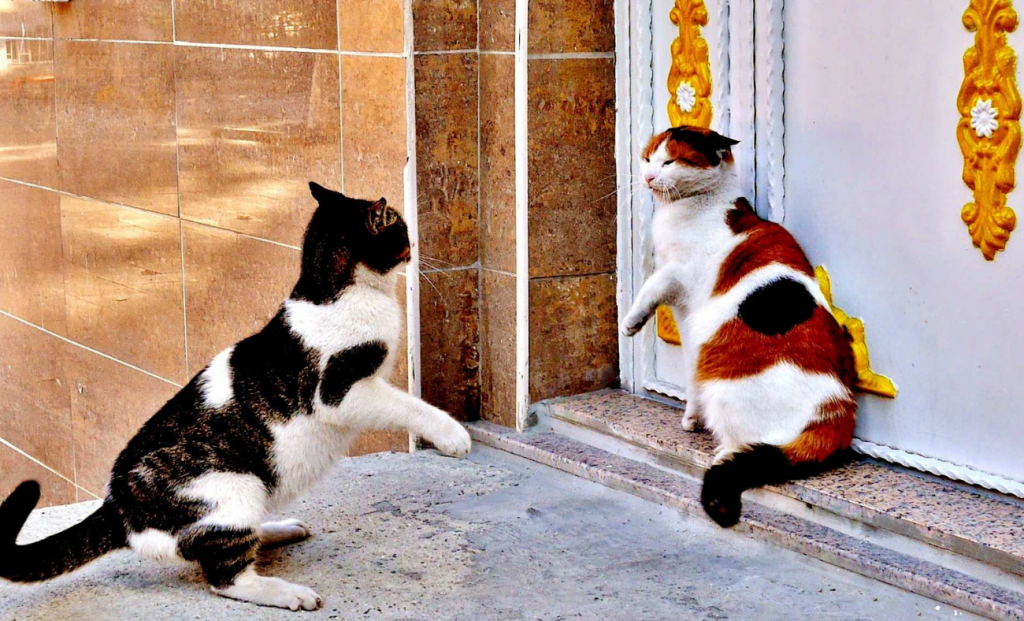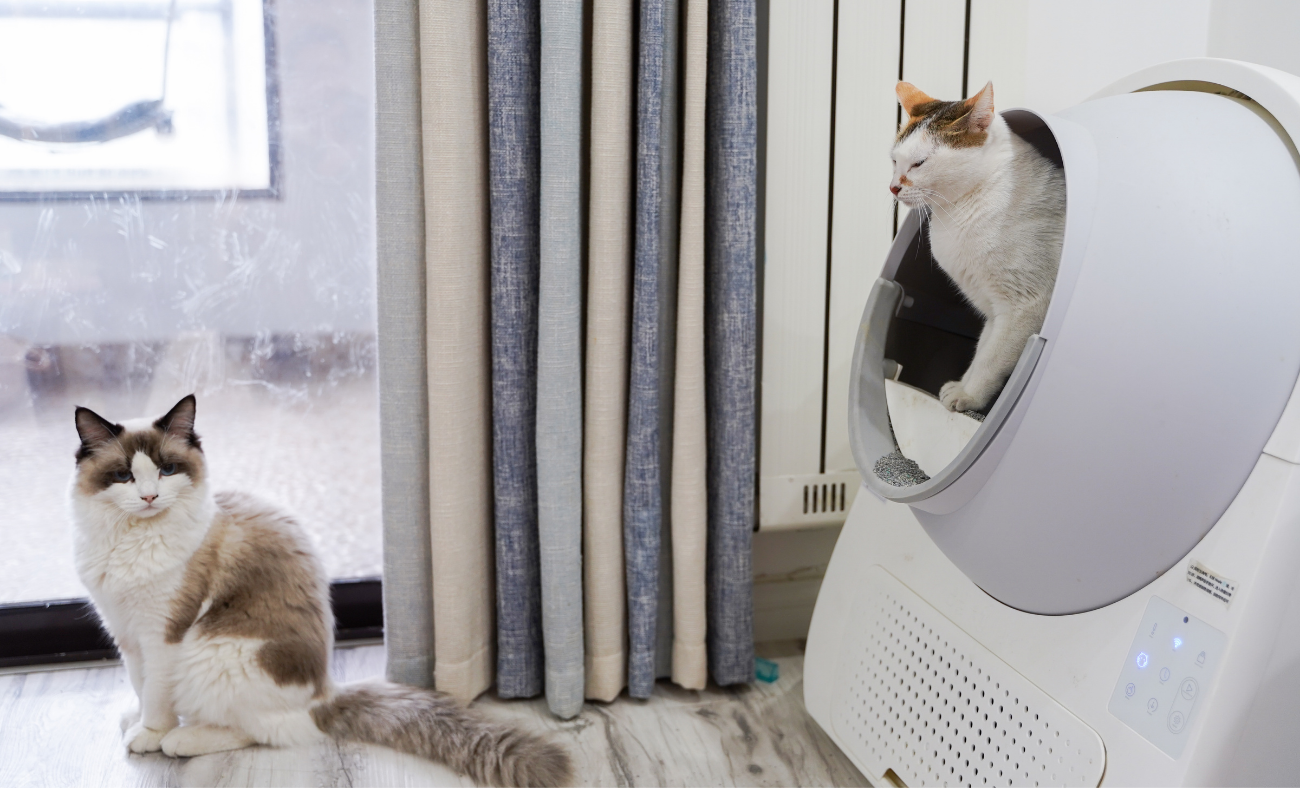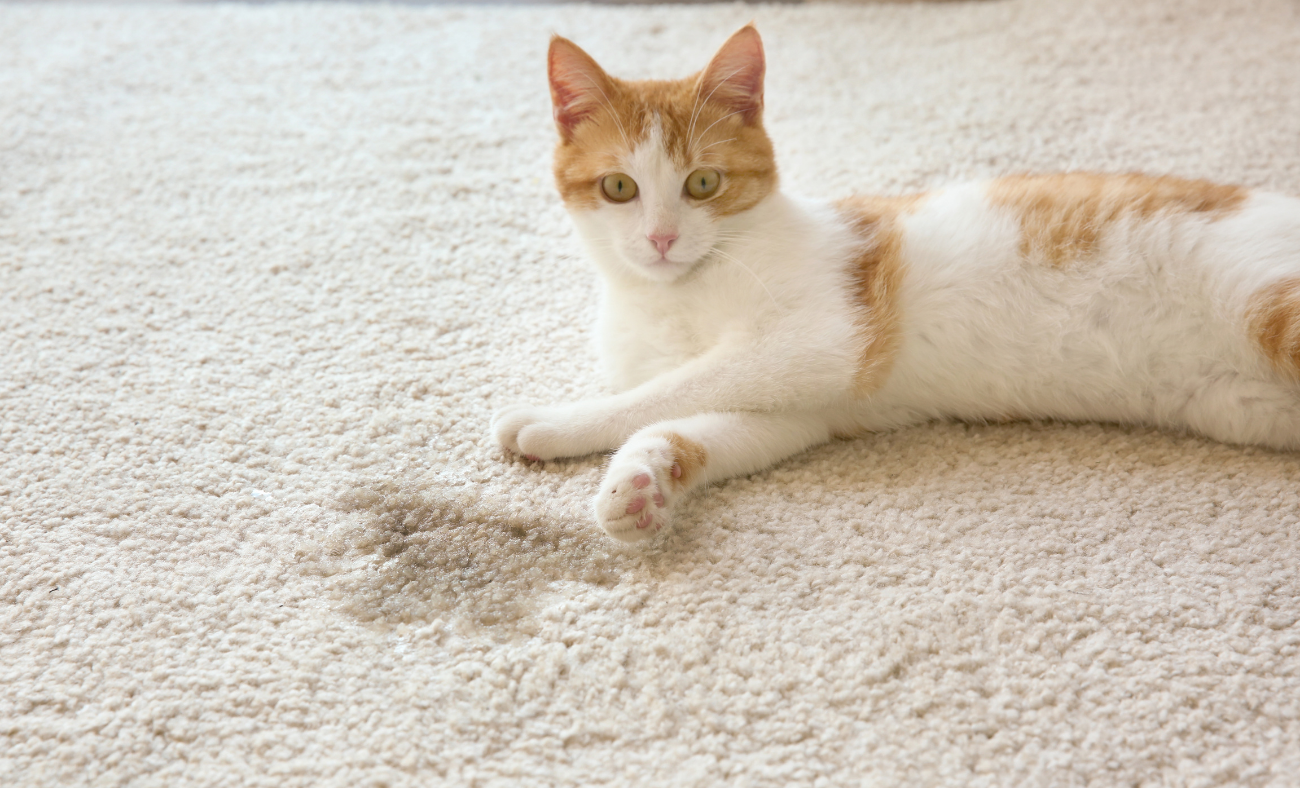The urine smell hit me the moment I walked through the front door.
Not the litter box. Not an accident. This was deliberate. Strategic. My usually well-behaved cat had marked the hallway wall, and from the pungent intensity, this wasn’t the first time.
I stood there, grocery bags in hand, trying to process what this meant. My cat had never done this before. She was litter trained. She was clean. She was… stressed.
What I didn’t realize in that moment was that I was witnessing the beginning of a territorial anxiety crisis that would teach me more about cat stress and anxiety than years of casual cat ownership ever had. The marking wasn’t defiance or spite. It was a desperate attempt at communication from a cat whose sense of security had been shattered by changes I hadn’t even noticed.
This experience opened my eyes to one of the most misunderstood cat anxiety symptoms that can destroy the harmony of multi-cat households and leave even single-cat families questioning everything they thought they knew about their feline companions.
The Moment Everything Changed
Two days earlier, everything had been normal. Perfect, even.
My cat used her litter box religiously. She shared space peacefully with our other household cats. She showed no signs of territorial aggression or resource guarding that might indicate underlying stress.
Then my neighbor’s cat started spending time in our yard.
I barely noticed the outdoor visitor at first. Just a glimpse of orange fur through the window. A brief sighting near the bird feeder. Nothing that seemed remotely connected to indoor cat behavior or household dynamics.
But my cat noticed. And that outdoor presence triggered a cascade of territorial anxiety that manifested in ways I never could have predicted.
The urine marking was just the beginning.
Understanding Territorial Anxiety in Cats
Anxiety in cats often centers around territory and resource security in ways that most cat parents don’t fully understand.
Cats don’t just live in our homes. They create complex territorial maps that include preferred pathways, safe zones, resource locations, and boundary markers that help them feel secure in their environment.
When something threatens their territorial security, even perceived threats they can’t directly access, cats can develop anxious cat behavior that seems completely disconnected from the actual trigger.
My cat’s territorial anxiety wasn’t about the physical presence of another cat in her space. It was about the threat to her territorial boundaries that existed only in her mind. The outdoor cat represented potential competition for resources, potential invasion of her safe space, and potential disruption of the territorial security she’d established over years of peaceful coexistence.
Understanding this distinction became crucial for addressing her cat stress symptoms effectively.
The Escalation Pattern Nobody Warns You About
Territorial anxiety doesn’t start with dramatic urine marking or aggressive resource guarding.
It begins with subtle changes that most cat parents dismiss as normal behavioral variations.
The first sign was increased window monitoring. My cat started spending hours watching the areas where she’d spotted the outdoor visitor. This seemed like normal curiosity initially, but the intensity and duration of her surveillance suggested something more concerning.
Her patrol patterns around the house changed next. She began checking and rechecking areas near windows and doors, establishing new monitoring routines that took up increasing amounts of her daily energy.
Sleep patterns shifted as her hypervigilance increased. She startled more easily at outdoor sounds. Her overall alertness level increased in ways that suggested chronic stress rather than healthy environmental awareness.
The urine marking came last, representing the culmination of territorial anxiety that had been building for days.
Recognizing the Triggers Most People Miss
Using the same analytical thinking that had served me well in corporate problem-solving, I began systematically identifying the environmental factors that had triggered her territorial anxiety.
The outdoor cat was obvious. But other factors had contributed to her sense of territorial insecurity.
Recent changes in our household routine had altered her territorial patrol schedule. New furniture placement had disrupted her preferred pathways through the house. Even subtle changes in cleaning products had altered familiar scent markers that helped her feel secure in her environment.
Cat stress and anxiety around territory often involves multiple small changes that accumulate until they overwhelm a cat’s ability to maintain their sense of security.
Identifying these contributing factors became essential for developing effective intervention strategies that addressed root causes rather than just managing symptoms.

The Multi-Cat Household Complication
Our household dynamic included multiple cats, which added layers of complexity to territorial anxiety management that single-cat households don’t face.
When one cat develops territorial anxiety, it affects the entire household social structure.
My anxious cat’s increased territorial marking created stress for the other cats, who suddenly found their shared space marked with anxiety-scent that disrupted their own sense of security.
Resource competition increased as her territorial anxiety made her more protective of food bowls, water stations, and preferred resting areas.
The social hierarchy shifted as her anxiety-driven behaviors created tension that affected everyone’s daily routines and comfort levels.
Managing territorial anxiety in multi-cat households requires understanding how individual cat stress impacts group dynamics and implementing solutions that support both the anxious cat and the household community.
Creating Systematic Territory Management
Drawing on my experience with systematic problem-solving, I approached her territorial anxiety crisis using the same methodical approach I’d use for any complex challenge requiring multiple intervention strategies.
The first step involved environmental assessment to identify and address the triggers contributing to her territorial insecurity.
I blocked her visual access to areas where she’d spotted the outdoor cat, reducing the constant reminder of potential territorial threats.
Scent management became crucial for restoring her sense of territorial security. I cleaned all marked areas with enzyme cleaners that completely eliminated scent markers, then reestablished positive scent associations using familiar items like her bedding and favorite toys.
Resource optimization involved creating multiple feeding stations, water sources, and resting areas throughout the house, reducing potential competition and giving her abundant territorial security around essential resources.
The private sanctuary I’d created during her stress-induced cystitis episode again became essential, providing her with undisputed territory where she could retreat and feel completely secure.
Implementing Multi-Modal Intervention
My systematic approach to complex problems taught me that sustainable solutions require addressing multiple contributing factors rather than focusing on single-point fixes.
Environmental modifications formed the foundation of territorial anxiety management, but they weren’t sufficient by themselves.
Feliway pheromone diffusers became part of a broader scent management strategy that included maintaining familiar scent markers throughout the house while eliminating anxiety-related scent markers from territorial marking.
Increased environmental enrichment provided appropriate outlets for territorial behaviors through climbing structures, hiding spots, and interactive elements that satisfied her need for territorial control without creating household conflict.
Routine consistency helped rebuild her sense of territorial predictability by maintaining regular feeding schedules, play sessions, and household activities that reinforced her territorial security.
Monitoring Progress and Preventing Relapse
Tracking her territorial anxiety recovery required systematic observation of both obvious indicators like urine marking and subtle behavioral changes that might indicate returning territorial stress.
I documented the frequency and location of any marking incidents, correlating these with environmental changes or stressors that might trigger territorial anxiety.
Her window monitoring behavior served as an early warning system for territorial stress. Increased surveillance or agitation near windows indicated rising anxiety levels before they escalated to marking behavior.
Social interactions with the other household cats provided another indicator of her territorial security. Increased resource guarding or social tension suggested territorial anxiety that needed immediate intervention.
Environmental factors like outdoor cat activity, household changes, or routine disruptions required proactive management to prevent territorial anxiety relapse.
Long-Term Territorial Security
The ultimate goal wasn’t simply eliminating territorial marking but building lasting territorial confidence that could withstand normal environmental changes and stressors.
This required understanding her individual territorial needs and preferences well enough to maintain environmental conditions that naturally supported her sense of security.
Territorial anxiety management became an ongoing partnership built on environmental awareness, proactive stress prevention, and systematic responses to potential triggers before they escalated to marking behavior.

When Territorial Issues Require Professional Help
While many territorial anxiety cases respond well to environmental modifications and systematic stress reduction, persistent or severe territorial behaviors may indicate underlying issues requiring professional evaluation.
Cat anxiety symptoms that include aggressive territorial behaviors, property destruction, or complete territorial resource monopolization warrant consultation with veterinary behaviorists who can assess whether medical issues contribute to territorial stress.
Multi-cat households with ongoing territorial conflicts often benefit from professional guidance in restructuring environments and social dynamics to support all cats’ territorial needs.
Understanding when territorial anxiety moves beyond normal stress responses to serious behavioral disorders requires careful documentation and professional assessment of both individual cat needs and household dynamics.
Your Path to Territorial Harmony
Recognition that territorial marking or resource guarding might indicate underlying territorial anxiety rather than behavioral defiance opens the door to more effective intervention strategies.
These behaviors represent communication attempts from cats whose territorial security has been compromised by environmental factors that may not be obvious to their human families.
When cat stress and anxiety reaches the point of territorial marking or aggressive resource guarding, the situation demands systematic environmental assessment and modification that addresses both immediate triggers and underlying security needs.
Understanding territorial anxiety requires patience, observation, and commitment to creating environmental conditions that naturally support your cat’s need for territorial security and resource access.
Every cat deserves to feel secure in their territorial boundaries and confident in their resource access. That’s why I developed the Cat Stress Signal Checklist — to help cat parents like you identify territorial anxiety indicators before they escalate to marking behavior or household conflicts.
Your cat’s territorial behaviors offer valuable insights into their environmental security needs and stress management requirements. When you understand how to read these territorial messages, you can provide the systematic environmental support that transforms territorial anxiety into confident, comfortable home ownership.
So, if you’re ready to dive deeper into your cat’s territorial security needs, then download our FREE comprehensive Cat Stress Assessment Checklist: The Essential 12 Hidden Signals. This will enable you to systematically assess your cat’s current stress levels and create a personalized plan for building their territorial confidence.
This practical tool guides you through the subtle signs of territorial anxiety and provides actionable steps for creating the secure environment your cat truly deserves.


